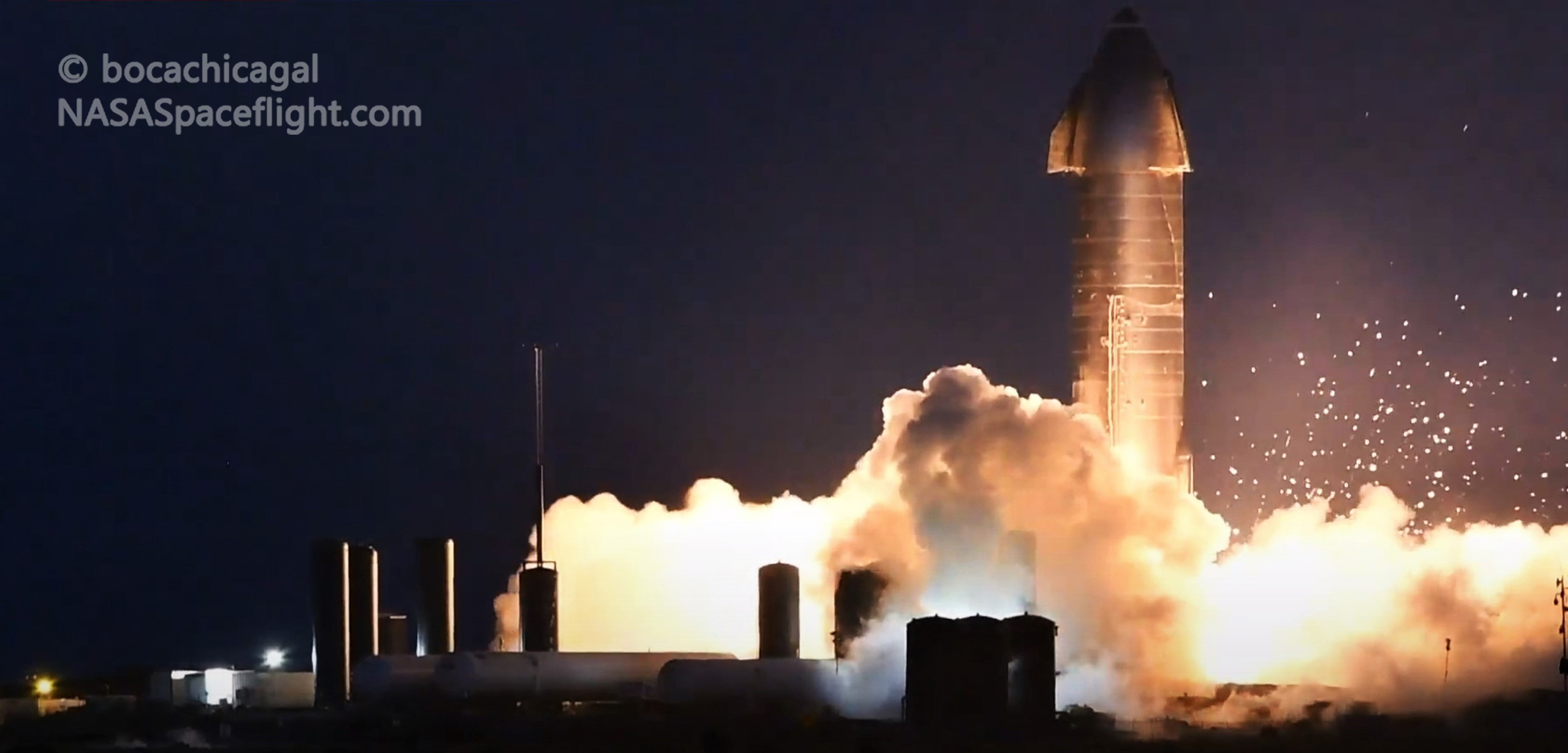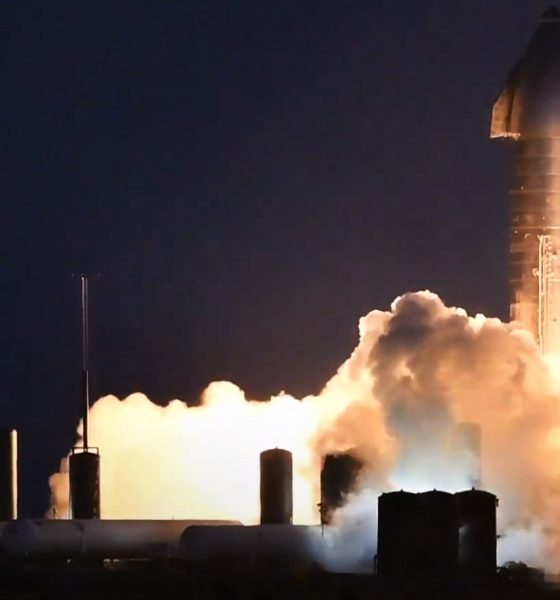

News
SpaceX Starship wraps up nosecone ‘cryo proof’ and first of several Raptor static fires
SpaceX has successfully ‘cryoproofed’ the first fully-assembled Starship prototype’s nose-based propellant tank and used that same tank to fire up a Raptor engine, crossing off one of the last major tests before the rocket’s 15-kilometer (~9.5 mile) launch debut.
On November 4th, after a few false-starts, Starship Serial Number 8 (SN8) kicked off its first round of testing after becoming the first prototype to have a nose section permanently installed. On that Wednesday evening, SpaceX most likely put the rocket through a partial cryogenic proof test explicitly focused on SN8’s new nosecone and a small secondary propellant tank situated in its tip. Designed to act as a secondary reservoir for the relatively small amount of propellant Starships need to land, SN8’s two header tanks were likely loaded with cryogenic liquid nitrogen – a safe, nonreactive stand-in for liquid oxygen and methane.
Having proven that Starship SN8’s newly-installed liquid oxygen header tank and associated plumbing is capable of loading, managing, and offloading dozens of tons of cryogenic fluid while navigating a 40-meter-tall (~130 ft) vertical pipe, SpaceX was ready to move onto the next step: a wet dress rehearsal (WDR) and Raptor static fire.
While SpaceX has technically completed eight successful Raptor static fires on four separate prototypes, including the first three-Raptor static fire ever attempted with Starship SN8, the company has never attempted a static fire while solely drawing propellant from header (landing) tanks. All but essential for Starships to be able to reliably reignite their Raptor engines in flight and keep cryogenic landing propellant liquid for hours, days, weeks, and even months, much smaller header tanks make it easier to keep propellant highly pressurized and in the right place to supply Raptors.
After several days of test windows come and gone and an aborted attempt on November 9th, Starship SN8 finally ignited one of its three Raptor engines, feeding the engine with liquid methane and oxygen stored in two separate header tanks. Oddly, a second or two after startup and ignition, Raptor’s usual exhaust plume was joined by a burst of shiny firework-like debris. A relatively normal five seconds later, the Raptor cut off, though the engine appeared to remain partially on fire for another ten or so seconds – also somewhat unusual.
Ultimately, the observed anomaly could be as simple as debris accidentally left in the vicinity of Raptor’s plume or, while less likely, concrete erosion. There’s also a chance that it was pieces of Raptor’s complex turbopumps or preburners, although it’s also unlikely that the engine would have continued running (as it did) if it had lost that much internal hardware.
(Update: Thankfully, NASASpaceflight.com reporter Michael Baylor says that the cloud of debris observed on November 10th “is not a [Raptor performance] concern,” making pad debris the likely source.)
SpaceX has canceled another static fire window on November 11th, leaving the next opportunity for a second (of three) expected static fire between 9am and 9pm CST (UTC-5) on Thursday, November 13th.

News
Tesla FSD fleet is nearing 7 billion total miles, including 2.5 billion city miles
As can be seen on Tesla’s official FSD webpage, vehicles equipped with the system have now navigated over 6.99 billion miles.

Tesla’s Full Self-Driving (Supervised) fleet is closing in on almost 7 billion total miles driven, as per data posted by the company on its official FSD webpage.
These figures hint at the massive scale of data fueling Tesla’s rapid FSD improvements, which have been quite notable as of late.
FSD mileage milestones
As can be seen on Tesla’s official FSD webpage, vehicles equipped with the system have now navigated over 6.99 billion miles. Tesla owner and avid FSD tester Whole Mars Catalog also shared a screenshot indicating that from the nearly 7 billion miles traveled by the FSD fleet, more than 2.5 billion miles were driven inside cities.
City miles are particularly valuable for complex urban scenarios like unprotected turns, pedestrian interactions, and traffic lights. This is also the difference-maker for FSD, as only complex solutions, such as Waymo’s self-driving taxis, operate similarly on inner-city streets. And even then, incidents such as the San Francisco blackouts have proven challenging for sensor-rich vehicles like Waymos.
Tesla’s data edge
Tesla has a number of advantages in the autonomous vehicle sector, one of which is the size of its fleet and the number of vehicles training FSD on real-world roads. Tesla’s nearly 7 billion FSD miles then allow the company to roll out updates that make its vehicles behave like they are being driven by experienced drivers, even if they are operating on their own.
So notable are Tesla’s improvements to FSD that NVIDIA Director of Robotics Jim Fan, after experiencing FSD v14, noted that the system is the first AI that passes what he described as a “Physical Turing Test.”
“Despite knowing exactly how robot learning works, I still find it magical watching the steering wheel turn by itself. First it feels surreal, next it becomes routine. Then, like the smartphone, taking it away actively hurts. This is how humanity gets rewired and glued to god-like technologies,” Fan wrote in a post on X.
News
Tesla starts showing how FSD will change lives in Europe
Local officials tested the system on narrow country roads and were impressed by FSD’s smooth, human-like driving, with some calling the service a game-changer for everyday life in areas that are far from urban centers.

Tesla has launched Europe’s first public shuttle service using Full Self-Driving (Supervised) in the rural Eifelkreis Bitburg-Prüm region of Germany, demonstrating how the technology can restore independence and mobility for people who struggle with limited transport options.
Local officials tested the system on narrow country roads and were impressed by FSD’s smooth, human-like driving, with some calling the service a game-changer for everyday life in areas that are far from urban centers.
Officials see real impact on rural residents
Arzfeld Mayor Johannes Kuhl and District Administrator Andreas Kruppert personally tested the Tesla shuttle service. This allowed them to see just how well FSD navigated winding lanes and rural roads confidently. Kruppert said, “Autonomous driving sounds like science fiction to many, but we simply see here that it works totally well in rural regions too.” Kuhl, for his part, also noted that FSD “feels like a very experienced driver.”
The pilot complements the area’s “Citizen Bus” program, which provides on-demand rides for elderly residents who can no longer drive themselves. Tesla Europe shared a video of a demonstration of the service, highlighting how FSD gives people their freedom back, even in places where public transport is not as prevalent.
What the Ministry for Economic Affairs and Transport says
Rhineland-Palatinate’s Minister Daniela Schmitt supported the project, praising the collaboration that made this “first of its kind in Europe” possible. As per the ministry, the rural rollout for the service shows FSD’s potential beyond major cities, and it delivers tangible benefits like grocery runs, doctor visits, and social connections for isolated residents.
“Reliable and flexible mobility is especially vital in rural areas. With the launch of a shuttle service using self-driving vehicles (FSD supervised) by Tesla in the Eifelkreis Bitburg-Prüm, an innovative pilot project is now getting underway that complements local community bus services. It is the first project of its kind in Europe.
“The result is a real gain for rural mobility: greater accessibility, more flexibility and tangible benefits for everyday life. A strong signal for innovation, cooperation and future-oriented mobility beyond urban centers,” the ministry wrote in a LinkedIn post.
News
Tesla China quietly posts Robotaxi-related job listing
Tesla China is currently seeking a Low Voltage Electrical Engineer to work on circuit board design for the company’s autonomous vehicles.

Tesla has posted a new job listing in Shanghai explicitly tied to its Robotaxi program, fueling speculation that the company is preparing to launch its dedicated autonomous ride-hailing service in China.
As noted in the listing, Tesla China is currently seeking a Low Voltage Electrical Engineer to work on circuit board design for the company’s autonomous vehicles.
Robotaxi-specific role
The listing, which was shared on social media platform X by industry watcher @tslaming, suggested that Tesla China is looking to fill the role urgently. The job listing itself specifically mentions that the person hired for the role will be working on the Low Voltage Hardware team, which would design the circuit boards that would serve as the nervous system of the Robotaxi.
Key tasks for the role, as indicated in the job listing, include collaboration with PCB layout, firmware, mechanical, program management, and validation teams, among other responsibilities. The role is based in Shanghai.
China Robotaxi launch
China represents a massive potential market for robotaxis, with its dense urban centers and supportive policies in select cities. Tesla has limited permission to roll out FSD in the country, though despite this, its vehicles have been hailed as among the best in the market when it comes to autonomous features. So far, at least, it appears that China supports Tesla’s FSD and Robotaxi rollout.
This was hinted at in November, when Tesla brought the Cybercab to the 8th China International Import Expo (CIIE) in Shanghai, marking the first time that the autonomous two-seater was brought to the Asia-Pacific region. The vehicle, despite not having a release date in China, received a significant amount of interest among the event’s attendees.








